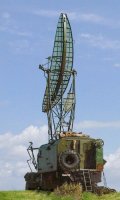PRV-16 “Thin Skin B”
Description of the radar set, tactical-technical characteristics

Figure 1: PRV-16 „Thin Skin B”

| Specifications | |
|---|---|
| frequency: | 5 … 9 GHz |
| pulse repetition time (PRT): | 2.5 and 1.25 ms |
| pulse repetition frequency (PRF): | 400 and 800 Hz |
| pulsewidth (τ): | 1.75 µs |
| receive time: | |
| dead time: | |
| peak power: | 700 kW |
| average power: | 490 … 560 W |
| instrumented range: | 162 NM (≙ 300 km) |
| range resolution: | 1.5 km |
| beamwidth (azimuth): | 2.5° |
| beamwidth (elevation): | 0.5° |
| hits per scan: | > 12 |
| MTBCF: | |
| MTTR: | |
PRV-16 “Thin Skin B”
The PRW-16 is a height-finder radar used in the former Warshaw Pact. It is the successor of PRV-9. It was developed in the mid 60s, and from about 1970th it was used in the Soviet army.
Characteristic features of:
- tunable magnetron;
- depending on the interference environment and after automatic analysis of the disturbances, it seeks the best transmitting frequency for the next pulse;
- time required for the re-tuning over the entire frequency range: <1s;
- Interfering protection systems SBZ+UNS using 2 potentialoscopes of type LN 12;
- Swivel cycle of the antenna: 3.2 s (= nods 18 times per minute);
- time required for raising or folding down the antenna 4.5 min.
